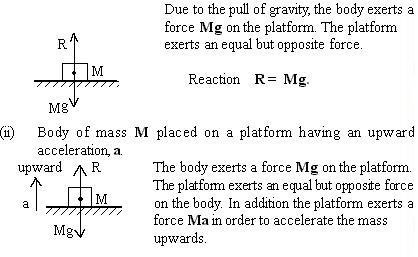- Equations of motion.
- Newton's laws of motion.
- Principle of conservation of mechanical energy.
- Laws of solid friction.
Equations
of motion for uniformly accelerated rectilinear motion
The following symbols are used in this textbook:
t = time, v = final velocity, u = initial velocity
s = distance and a = acceleration.
(i) Relation between v, u, a and t .
a = ( v - u )/t
v = u + at ----------------------- (1)
(ii) Relation between s, u, t and a.
Average velocity = s/t = ( v + u )/2
s = ½(v + u ) t but v = u + at
s = ½(u + at + u )t
s = ut + ½ at2 ----------------- (2)
(iii) Relation between s, v, u and a.
Combining equation (1) and equation (2)
s = u (v - u )/a + ½ a( v - u )2/a
2as = 2u (v - u) + (v - u)2
2as = v2 - u2
v2 = u2 + 2as --------------------
(3)
(Online Resource)
Mechanics
including graphs
NEWTON'S LAWS OF MOTION
Law 1: A body in its state of rest or moving in
a straight line continues to do so unless acted on by an
external force.
This inherent reluctance of matter to any change of motion
is called inertia and law 1 may be referred
to as the "Principle of inertia". The inertia of
a body increases with mass.
The effects of inertia can be observed by passengers in
a bus. There is a forward jerk when the vehicle stops (the
motion of the passengers tending to persist ), and a backward
jerk when the vehicle re-starts (the passengers tending
to remain stationary).
Law 2: The rate of change of momentum of a body
is proportional to the resultant force on the body and takes
place in the direction of the force.
Momentum is the product of mass and velocity of a moving
body.
Force = (change in momentum )/time
F = (mv - mu)/t = m(v - u)/t = ma.
F = ma
N.B: F is resultant force obtained by identifying
forces acting on the system and finding the net force in
the direction of motion.
Law 3: Action and reaction are equal but opposite.
Some illustrations of identification of forces and the application
of Newton's laws of motion.
(i) Body of mass M placed on either a stationary
platform or a platform moving at constant speed.

Total force exerted by the platform = Reaction R
= M(g + a)
N.B: An upward acceleration has the same effect
as a downward retardation.

